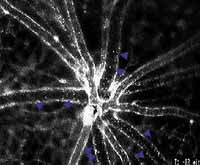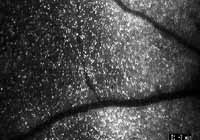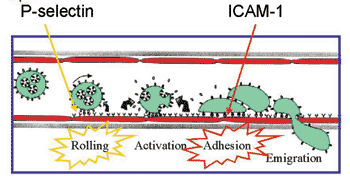Study investigates role of leukocytes in post-ischemic retinal damage
Leukocyte behavior was observed in rat eyes after inducing retinal ischemia.
 |
| Rolling leukocytes can be seen in the retinal veins. |
 |
| Leukocyte accumulation in the retinal microcirculation is seen during reperfusion. |
NAGOYA, Japan — Leukocytes play a significant role in post-ischemic retinal damage, according to a study conducted by Yuichiro Ogura, MD, from the Nagoya City University Medical Hospital, located here.
“The role of leukocytes in heart, brain and mesentery ischemia has been demonstrated by many authors. Leukocytes block the blood flow and produce free radicals or cytokines, leading to tissue injury,” said Prof. Ogura. Further studies suggest that reperfusion-induced tissue damage could be reduced by preventing leukocyte activation or accumulation. “However, since very little is known about the role of leukocytes in retinal ischemia, we felt the need to investigate it, in particular the specific interactions between leukocytes and the endothelial cells of retinal vessels,” he explained.
In the study, retinal ischemia was experimentally induced in rats, and leukocyte behavior was evaluated using acridine orange fluorescein angiography (FA).
“Acridine orange is a dye that stains nucleic acids. We used it as a means of visualizing leukocytes in the microcirculation of the retina in vivo with the aid of a scanning laser ophthalmoscope,” Prof. Ogura said.
To induce ischemia, the optic nerves of the rats were sutured in the retrobulbar area to stop blood flow from the central retinal artery. After 60 minutes the suture was released to obtain blood reperfusion. Acrydine orange FA was performed at 1, 2, 4, 6, 12 and 24 hours and 2, 4 and 7 days after reperfusion.
“We were able to detect a high number of leukocytes ‘rolling’ in the retinal vessels and could easily count them. They appeared 4 hours after reperfusion started and peaked at 12 hours. We also observed that leukocytes had a tendency to stop and accumulate in some points of the vessels over a certain period of time. Leukocyte accumulation reached its peak at 24 hours after reperfusion,” said Prof. Ogura.
Leukocyte-endothelium interaction
The interaction between leukocytes and vascular endothelial cells was clearly illustrated by Prof. Ogura. When a stimulus such as ischemia attacks the endothelium, leukocytes slowly move along over the endothelium, “rolling” on the endothelial layer. In this process they become activated, settle on the surface and adhere firmly to it. Later they migrate out of the vessels, invade tissue and take part in complex post-ischemic inflammatory reactions and tissue damage.
“Many adhesion molecules participate in this process. P-selectin gives way to the initial leukocyte-endothelium interaction (the rolling stage) and ICAM-1 is involved in adhesion and emigration. Hence, if the activity of these molecules is suppressed, the entire process of leukocyte activation could be jeopardized,” said Prof. Ogura.
Inhibiting leukocyte activity
To prove this assumption, Prof. Ogura induced retinal ischemia in other rats, but blocked P-selectin and ICAM-1 with specific antibodies. Acridine orange FA showed that the P-selectin antibody effectively inhibited leukocyte rolling during reperfusion and leukocyte accumulation was greatly reduced by ICAM-1 antibodies.
“The ischemic tissue damage was evaluated histologically. We could observe that the inner retinal atrophy after ischemia was reduced in the eyes where leukocyte activity was reduced by inhibition of adhesion molecules,” said Prof. Ogura.
“By our experiments,” he continued, “we could therefore prove that leukocytes play a significant role in the ischemic reperfusion damage of the retina, but also that there are ways of interfering with their destructive processes.”
 
Leukocyte-endothelial interaction. When a stimulus such as ischemia attacks the endothelium, leukocytes slowly move along over the endothelium, “rolling” on the endothelial layer. In this process they become activated, settle on the surface and adhere firmly to it. Later they migrate out of the vessels, invade tissue and take part in complex post-ischemic inflammatory reactions and tissue damage. |
For Your Information:
- Yuichiro Ogura, MD, is head of the Department of Ophthalmology at Nagoya City University Medical School. He can be reached at Mizuho-ku, Nagoya 467-8601, Japan; +(81) 52-853-8251; fax: +(81) 52-841-9490; e-mail: ogura@med.nagoya-cu.ac.jp. Dr. Ogura has no direct financial interest in any of the products mentioned in this article, nor is he a paid consultant for any companies mentioned.
